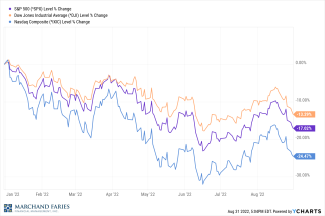
September 1, 2022
In the U.S. more conservative spending behaviors by consumers have occurred along with a dip into savings. Less than a year ago, American households were estimated to have savings of around $2.6 trillion by the end of 2021. To date, consumers have spent almost 6% of this to keep up with rising prices. At this rate, consumers are expected to run through a third of the cushion by the end of next year.
And now for some good news; US companies continue to believe in capitalism. New issue fixed income investments will start to pay better than in past years where money markets have paid virtually nothing in the most recent past. Quality and sustainability of investments are still significant and play a part in continued long-term growth.
As we finish out the summer, volatility will continue to be the mantra. We do not expect talk on tax increases until after the November midterms, when the reality of paying off debt and expansion programs becomes more relevant to lawmakers.
Year-to-date Dow, S&P 500, and NASDAQ have improved slightly but remain negative at -13.29%, -17.02% and -24.47% respectively, while the 10-year Treasury yield is currently yielding 3.11%.
*Disclaimer: This report is a publication of Marchand Faries Financial Management, Inc. Information presented is believed to be factual and up-to-date, but we do not guarantee its accuracy and it should not be regarded as a complete analysis of the subjects discussed. All expressions of opinion reflect the judgement of the author as of the date of publication and are subject to change.

